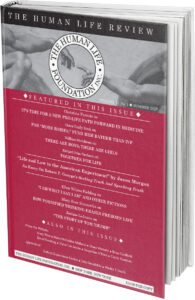IVF: The Frozen Sleep Evading Time
This article previously appeared in AMERICAN THINKER May 4, 2025, here and is used with permission.
___________________________________________________________________________
Lost in Space was a hit sci-fi show when I was growing up, and “Condemned of Space” was one of my favorite episodes. The Jupiter 2 landed on a prison ship whose inmates served their time in a “frozen sleep.” Unfortunately, the cold also froze the chronometer, resulting in the prisoners serving a prolonged sentence.
Back in the 1960s, freezing people as a way of coping with long space voyages was the stuff of sci-fi. In the first Lost in Space episode, the Robinsons all enter freezing tubes to “age but a moment in the time of man” on their five-year journey to Alpha Centauri. (In the original pilot episode, the trip was going to last 99 years.)
A post on “X” this past week made me realize that stopping time through freezing is no longer the stuff of sci-fi.
The post was a video of a 14-year-old boy holding his newborn brother. Perfectly ordinary, you say, ‘til you read the background. Both boys were conceived through in vitro fertilization (IVF) in 2010.
As is usual, multiple ova are “harvested” and fertilized, with the one(s) judged “most likely to succeed” implanted in the mother. The rest are either discarded or frozen (“cryogenically preserved”) for possible eventual use. There are literally millions of such frozen unborn children worldwide.
One of the main criticisms of IVF is that it turns the human act of procreation through personal sexual intercourse into a clinical procedure of gamete transfer. The truth is, like it or not, by accepting this equivalency, one denigrates the personal sexual touch: it becomes just another, maybe more “natural” or “organic” technique to have a baby, but that’s it.
But the “X” video I saw makes something else clear: IVF also separates human beings from age.
These boys are brothers. They come from ova from the same woman. (Whether that woman is the mother who bore and/or raised them is unsaid.) They’re brother…but are they “twins?”
Back in the bad old days when people had babies the “natural” way, a woman who conceived or was carrying two unborn children was said to be having “twins.” Well, these two boys were conceived at the same time back in 2010. But one was implanted, one was put on ice. Can you have “twins” separated by 13 years?
Some people would resolve the dilemma by saying twins are born together. Let’s explore that. If birth makes you twins, what are you two before birth? Don’t we say a mother is “having twins?” And if something went awry during pregnancy and the mother miscarried one of them, would you say the survivor was never a twin?
To equate being a “twin” with being born further perpetuates the fiction haunting American law that when life begins is an insoluble conundrum the law cannot answer. It’s probably why the pro-abortion crowd has glommed on to “IVF access”—it leaves the question of when life begins unresolved, while pictures of wanted newborns are more appealing than dismembered fetuses.
(I won’t raise the civil and democratic nonsense of such a position. A society exists to protect its members, and the most basic way it protects them is by keeping them alive. If a society cannot define when one is alive, it does not know who its members are and, therefore, towards whom it has obligations.
By fudging the issue of relationship and age, we basically eviscerate the meaning of a term like “twin” or “triplet.” IVF, according to its standard practice, rips the unborn out of a very human reality: aging. It’s the new “fountain of youth.”
That’s not really true, of course. For one, while IVF proponents don’t want to count time spent in the “frozen sleep” of cryogenic preservation until birth as age, it is counted towards death. How so?
In Britain, you used to be able to freeze embryos for a maximum of ten years. That was the “use/discard by” date. Since 2022, the law has changed: you can now leave an embryo on ice for 55 years (but you must renew the contract every ten).
Consider the implications: The 14-year-old kid shown holding his brother could literally have his grandson holding up his “twin” brother if they lived in Britain.
Let’s assume the 14-year-old was holding his twin brother, who was also born and raised by their common mother. (That’s a big assumption, because IVF and surrogacy allow us to slice and dice maternity into “genetic,” “gestational,” and “social” components.) A 55-year stint would be pushing that woman’s childbearing years, even with uterine transplants and hormonal abracadabra, beyond the breach. So, could the 14-year-old’s “brother” be gestated by his daughter? Maybe even granddaughter?
If “twin” loses its meaning, doesn’t “incest” lose it, as well? If genetic relationship no longer matters, is consanguinity just a state of mind?
These are the hard questions IVF poses that Americans, prone more towards feelings than thinking, avoid. Yes, one feels for married heterosexual couples who cannot bear a child. But the cost of those feelings is divorcing kids from relationship, genetics, biology, and even time. Is society willing to pay (or, more accurately, make the baby pay) that cost?
“Condemned of Space” makes sense provided you engage with a suspension of belief. But freezing Mr. Phanzig for 200+ years makes sense only if the people on his planet lived, say, 500 years. If they lived normal human lifetimes, the convenience of putting one’s criminals “on ice” would be to bring back recidivists centuries later. Imagine if we did that. We’d now be paroling convicts convicted under…President James Monroe.
But we may have to imagine it, because under current rules, if IVF had been possible back in the 1960s, we could be having a “twin” baby conceived when Richard Nixon was in his first term.










I’ve always been against I.V.F..Multiple human embryo’s are placed into the womb hoping that one will nidate.Those that don’t nidate are “sloughed-off” perish,die.Some doctors have called these ‘micro-abortions’.And some so-called medical workers are extracting stem cells from the surplus human embryo’s for research,killing the tiny human person.This is never good,either of them.
Pingback: The Human Life Review Thoughts on Baby Thaddeus - The Human Life Review